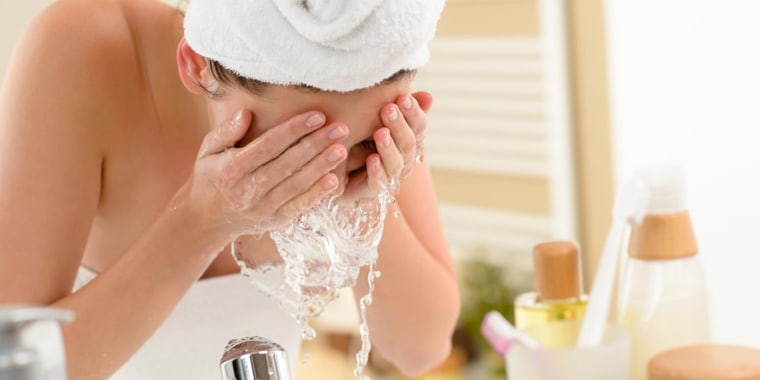Achieving glowing, blemish-free skin is tough. Many people are unaware that their everyday habits lead to unhealthy skin. And to complicate it, there is so much misinformation about skin health.
“Anyone can claim they are an expert. Be careful,” Dr. Adam Friedman, an associate professor of dermatology at George Washington School of Medicine in Washington, D.C., told TODAY.
But there's hope: There are a few common skin mistakes that are relatively easy to fix. Here they are:
1. Skimping on sunscreen.
“That’s probably the biggest mistake we see,” Dr. Apple Bodemer, assistant professor of dermatology at the University of Wisconsin School of Medicine and Public Health, told TODAY. “With sunscreen you need to apply it early, apply enough and re-apply."
Most people apply sunscreen immediately before going into the sun. But, it takes about 15 minutes for it to activate. And many people fail to use enough. Bodemer recommends people use a palmful for the entire body. The bigger the body, the bigger the palm filled with sunscreen.
“Usually people put a little dollop on their hand,” she said. “A 4-oz bottle of sunscreen should not last you all summer.”
For sunscreen to work it must be re-applied every two hours — or sooner after being in water.
“You need to not only apply it but to apply it again and again,” Friedman said.
For daily use, he also urges people to cover their necks and hands. Most people remember their faces but forget that their necks and hands are also exposed to the sun.
“People may have younger looking faces and 80-year-old hands,” he said.
2. Pimple popping.
“Never ever ever pop a pimple,” Friedman said. “There is no safe way to pop a pimple. It is the worst thing you can do and that injury will cause more inflammation.”
A pimple develops when oil becomes trapped in hair follicles and can’t escape. It creates inflammation and a raised bump. Pimples look unsightly and many believe that squeezing them to rupture them helps. But it does the opposite. Popping zits creates more inflammation and causes the oil to spread out under the skin.
“That blemish is going to be a lot bigger,” Bodemer said. “You are also at putting yourself at a higher risk of scarring.” And, popping pimples can cause people to develop infections.
3. Moisturizing at the wrong time.
Most people noticed cracked dry skin and lather it with lotion. But those conditions make it tough for the skin to retain the moisture.
“You have to put the moisturizer on damp skin right after a shower,” Friedman said. “Just changing that can make a difference for dry skin.”
This allows the moisturizer to get into the skin and create a protective barrier to prevent dried, cracked skin.
4. Getting a base tan to protect the skin.
“Tanning is a huge huge mistake,” said Bodemer. “It only takes one time in a tanning bed to increase your risk for skin cancer.”
A tan — or a burn — indicates that the skin is damaged. Getting a base tan doesn’t protect the body. Instead it makes it more likely a person will develop melanoma or other skin cancers.
5. Over-washing or using harsh cleansers to stop acne.
Sometimes people think that washing their faces more often or with harsher soaps will prevent acne. But that just causes more damage.
“With acne there is a problem with the skin barrier. Over-washing will do that too,” Friedman said.
And showering or bathing more won’t prevent excessive sweating. People who feel like they sweat too much should talk to a dermatologist instead of trying to treat it themselves.
“Bathing less is always more,” said Friedman.
6. Cutting cuticles.
While cuticles might seem unsightly, cutting them off can lead to bigger problems. Cuticles form a water-tight barrier that protect the nail bed from infection and irritation. Removing the cuticles ruins the barrier and yeast, bacteria, fungus and irritants can get into the nail bed. This can cause yellow, brown or brittle nails.
“We see nails that look like they are sick,” Bodemer said. “They tend to have chronic infections.”
7. Essential oils aren't created equal.
Friedman sees a lot of people who use essential oils for their skin. While some products work well, others fall short.
“There is evidence supporting the anti-inflammatory effects of these oils on skin," Friedman said.
But there's a catch.
"You don’t know what you are getting,” explained Friedman.
Essential oils are supplements and there's no oversight of them. Lavender oils from different companies might have entirely different ingredients and it is impossible for consumers to know what is in each one. And some of these added ingredients are common skin irritants. Tea tree oil, popular in numerous essential oils, commonly leads to contact dermatitis, for example.
“It is not just about the active ingredient. It is the whole product," he said.
If you're using a new product you're not quite sure about, talk to your dermatologist, and remember to keep up with annual skin scans. Noticing changes in your skin can help you spot issues.

